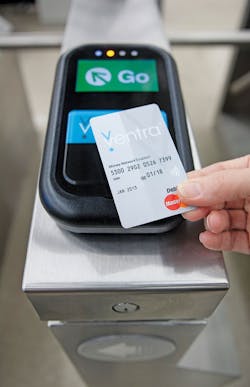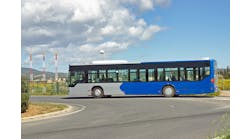People in the world’s premier cities are increasingly interconnected through digital and mobile technologies, and the ways they communicate, gather information and transact are in constant flux.
But the public transportation fare payment systems they use to move about have struggled to keep pace with the increasingly rapid rate of technologic change.
Challenges abound—not the least of which are capital and operational budget constraints and tradeoffs, multi-year procurement and development and implementation cycles. Perhaps the biggest obstacles are separate governmental oversight and funding authorities historically leading to different parts of urban public transportation networks operating completely separate payment, revenue management and customer service systems, creating disparities for agencies and riders alike. At the same time, several positive market forces are converging, including profound advancements in open systems architectures and electronic payments processing, as well as the ubiquity of consumer-owned mobile devices.
Progress is being made by seizing on these opportunities—progress which has become evident in Chicago, which has blown through these challenges to create the nation’s most advanced next-generation fare payment system, Ventra.
Full penetration
In what is one of the most complex projects Cubic Transportation Systems has undertaken, Ventra replaced Chicago’s nearly 20-year-old fare-payment system, which accepted magnetic stripe fare cards and the Chicago Card and Chicago Card Plus cards. The Chicago Card system, also provided by Cubic, delivered high levels of reliability and was popular with riders. As one of the earliest contactless smart-card fare payment systems in the U.S., it had been a state-of-the-art breakthrough for the industry. However, the system became outdated and the contactless chip it used had been out of production for some time; thus, the decision was made to move to a completely new system.
Ventra was a 12-year design-build-operate-maintain (DBOM) contract awarded by the Chicago Transit Authority (CTA) in November 2011 and self-financed by contract awardee Cubic Transportation Systems. Built on Cubic’s account-based technology, it is an open-payment system designed to accept contactless bankcards offered by all the leading payment brands as fare media directly at the turnstile, farebox and elsewhere.
The CTA-issued Ventra card includes a transit account and an optional prepaid debit account, creating the ability to pay for transit and everyday retail purchases, such as groceries, shopping online or dining out, all in one card. Cubic also was responsible for establishing and staffing customer service centers, building a walk-up center, basic account management, the Ventra website and developing and managing a retail network for Ventra card services.
Launched for a limited customer base in August 2013 for CTA and Pace, the Ventra system in less than a year reached 100% penetration when all CTA and Pace customers transitioned to the new system (which took place July 1, 2014).
The contactless Ventra card can be used for fare payment as well as retail purchases.
As of this writing, the Ventra system averages 42 million transactions per month and has realized 560 million total transactions to date. Active accounts sit at 4.2 million and registered accounts at 1.4 million. The facilitation of service has largely been handled through website self-service, which sees some 1.3 million visits per month, two-thirds of which come through the mobile-optimized site.
Where it stands
A few fast facts illustrate how the new system has changed the game in transit fare payment systems.
• Mobile payment: On Apple Pay’s first day of operation, Chicago transit riders could use their iPhones to pay for fares; Apple Pay did not exist when the system was procured and designed;
• Mobile services: Some 750,000 people use their mobile devices each month to check their fare card balances, add value or register for additional benefits on the mobile-optimized website;
• Account-based: The 100% account-based system handles both open payments and account-based cards with transit value and products; in account-based fare payment systems, the primary record of stored value resides in a back-office database instead of the card; this capability is essential to more flexible payment options, open payment and sharing one payment account across many agencies and modes of transportation;
• Open payment: Riders, including Chicago visitors, can use their contactless bankcards, or their NFC mobile wallets, to pay for fares at turnstiles and buses without buying a separate fare media; and
• Cross-agency, cross-modal open architecture: The open back-office architecture unifies transportation throughout the region, enabling the CTA, Pace Suburban Bus and soon Metra regional commuter rail to all share common rider fare payment accounts as well as customer service, processing and revenue management systems, while preserving their respective operating and business rules and general ledger systems, allowing the transit providers to bridge the existing “gated-gateless” divide in integrating fare payment systems.
A mobile tomorrow
Next up is the development of a single mobile app that will extend the system to work across Chicagoland’s three largest transit operators and bring the Metra regional commuter rail system into the system along with CTA and Pace.
This implementation is the first truly regional transit mobile app in the U.S. that integrates regional account management, trip tools, commuter rail mobile ticketing and NFC-enabled touch-to-pay capabilities through a virtual card into a single mobile app. Cubic and its partner Globe Sherpa will supply the integrated mobile app and system, giving travelers one, all-inclusive place to plan their journeys, pay and receive real-time alerts across all public-transit services in the Chicago region.
For the first time, Metra riders, who are today still using legacy fare media, will be able to use their mobile devices to buy various types of Metra tickets based on the train service line (e.g., selecting stations to provide appropriate fares) and provide a graphical animated ticket and barcode directly on the phone screen for validation. In addition, registered users will be able to manage their Metra mobile tickets.
Customers will be able to use the app to add value to their card and manage their account, including ordering and registering a card, checking balances and managing payment and auto load. Later, in future phases of the mobile initiative, additional features will include the ability to load a virtual card on an NFC mobile phone and richer trip-planning tools.
With the virtual card, riders can simply tap the mobile device at CTA rail turnstiles and board CTA and Pace buses to access the system.
The mobile app’s trip tools feature will provide users with valuable information to optimize their journeys, including when the next bus arrives or where the closest station is. In the cold Chicago winter, those extra six minutes in the coffee shop are certainly going to help. Today, riders have to go to various websites and apps to gather this information. With the app, that information will all be in one place.
Lessons learned
Over the course of development, implementation and finally evaluation of the system in Chicago, several important lessons were learned that could help other agencies plan and deploy their future fare payment and revenue-management systems.
Use of an account-based architecture is essential for cross-agency and multimodal support, open payment, mobile services and keeping pace with personal technology: Cubic’s NextCity plans for the future have always been to pioneer a system that not only lets riders pay for any mode of transportation through one account, but also will let multiple agencies or even separate companies share in the revenue management and customer service infrastructure. The foundation for all of these is an account-based architecture.
Support open payments to help keep pace with personal technology and payment innovations: Combining an account-based architecture with support for open payment dramatically improves the capability of transit agencies to keep pace with the changes taking place in the world around them. One example in the case of Ventra is the fact that Apple Pay and other NFC-based mobile wallets could be supported with no changes to the system.
Include a mobile-optimized website to fast-track mobile self-service convenience for riders in conjunction with a mobile app: The fact that two-thirds of Ventra.com visitors come through the mobile-optimized website is a strong testimony to its appeal to riders. This approach let Ventra fast-track the convenience of mobile self-service capabilities such as balance checking and reloading during the initial deployment while the mobile app was being developed.
Establish a revenue management and transaction processing core that can be shared across participating agencies while preserving their unique business rules: The system uses a core business rule engine that is both powerful and flexible, enabling CTA, Pace and Metra to each control their own business rules, pricing, revenue apportionment and transaction clearing. In addition, the payment processing, customer services, website and mobile capabilities can also be shared. This flexible foundation could be further extended to even non-governmental operations for things like ride or bike sharing, tolling or parking. This approach delivers the best of both worlds—the control and customization of separate systems as well as the many benefits of using a common platform. For one thing, a shared system costs less than buying and operating multiple ones. Finally, aggregating transactions generally has a favorable impact on unit costs and efficiency. This motivates program participants to bring in more agencies and promote more widespread use of the platform.
The Ventra program replaces the previous “Chicago Card”-based system, which became outdated when its contactless chip went out of production.
Choose a payment-processing engine that is already validated against PCI-DSS: Today, merchants accepting credit and debit cards are required by their acquiring banks to comply with the Payment Card Industry Data Security Standards (PCI-DSS). When implementing a system, it’s important to keep this in mind. Choosing a payment-processing engine that’s validated against these standards significantly reduces the effort of PCI testing and certification. It also gives peace of mind that at least the payment processing and data is secure while deploying and using the entire system, which has to be done in order to even start the testing process. While other aspects of the overall implementation would still require validation, the payment-processing core would not have to be re-validated. The system used this technology, saving time, cost and effort.
What it’s come to
In June 2015, Cubic and CTA were honored with the prestigious Best New Innovative Practice-Partnership Deployment award from the Intelligent Transportation Society of America (ITS America) in recognition of the innovative approach used to finance the Ventra project.
Cubic has helped CTA, Pace and Metra make ground-breaking progress in the evolution of fare-payment technology to maximize convenience and account security for riders. The account-based, open payment system also serves as a basis for a universal fare system, once again putting Chicago at the vanguard of next-generation fare-payment technology and establishing its reputation among the world’s premier cities as a forward-thinking metropolis of the future. TM&E



